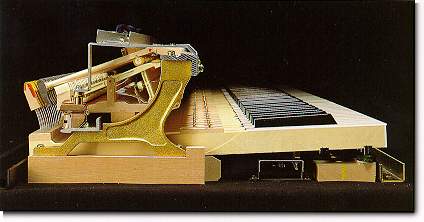Hello Ben, Joe (and Modartt),
I've been a long-time Pianoteq customer (since version 2) but have never posted anything on the Pianoteq forum. I recognize Ben's experiences with Ivory, so I thought I'd post something to share my enthusiasm. Like Ben, I was finally converted definitively by the new D4 and Bluthner models. Both are amazing technological achievements, I think, and especially the Bluthner is simply addictive to play.
With previous Pianoteq versions, I did feel there was a certain lack of realism to the basic piano tone, although I loved the responsiveness and playability and was convinced that physical modelling was eventually going to surpass sample-based methods. I think with the D4 and Bluthner Modartt have achieved that. My only gripe with Pianoteq is the microphone modelling. I find myself mostly preferring the Stereophonic mode to the Sound Recording mode, using the reverb to create a sense of space.
I bought Ivory 2 last year, mostly on the basis of the rave reviews it got, but have never been able to get along with it, not even with the Steinway (the Boesendorfer and Yamaha I think are not very good at all). It's OK to listen to as a recording but uninvolving to play; it feels like I'm constantly fighting the limitations of the software and the sample sets. Especially the velocity response doesn't feel right and Pianoteq is far smoother in this respect. I was interested (and a bit alarmed) to read about Ben's similarly experiences with the Ivory 2 Italian Grand.
The tone of Ivory 2 too lacks depth and warmth. Comparing Ivory II's Steinway to the D4 simply by playing middle C at various velocities, I was very surprised that the D4 actually has a warmer, fuller and richer tone than the sampled Ivory Steinway. The sympathetic resonance modelling in Ivory 2 is also thin compared to Pianoteq, and contains a weird metal zing that sounds unlike anything a real piano would do. The release samples are also less than convincing. There's audible reverb from the room in which the samples were recorded, and this gets cut off in an unnatural manner. In Pianoteq you hear the resonance of the piano body slowly fade away after you release the key, exactly as in a real instrument. This seems largely absent in Ivory 2, and as a result the notes don't always connect well. This is audible, for example, in the opening notes of the Chopin scherzo which Synthogy have as a demo on their website: the opening phrase sounds thin and unconnected to me. Even the new Steinway Concert D suffers from this, judging by the online demos.
Apologies for this anti-Ivory rant but it's a bit frustrating to buy a product that's been so well received and then find out it's not all that great.
Hats off to Modartt for creating the D4 and the Bluthner. Pianoteq will be my software piano from now on. I look forward very much to what else is in store. Considering the leaps which Pianoteq has made since 2007 (when I bought version 2), the future looks very bright indeed.
Happy playing to Ben, Joe and all other Pianoteq fans.
Jan
Last edited by Pianophile (02-10-2012 20:24)












